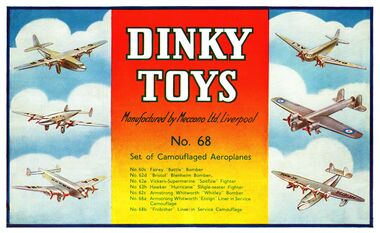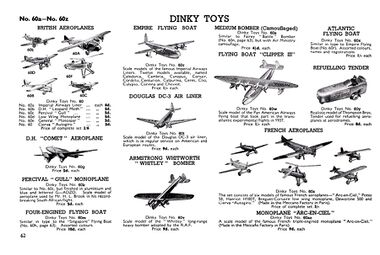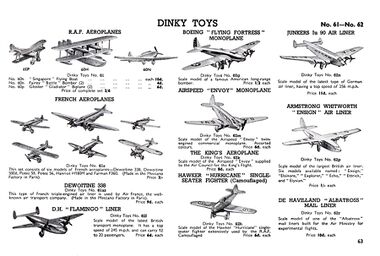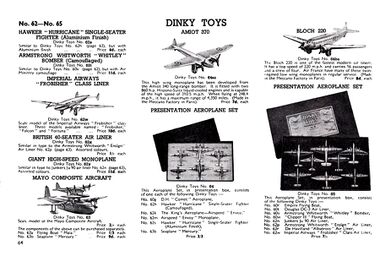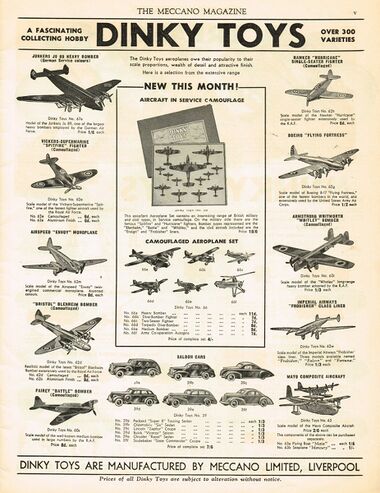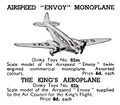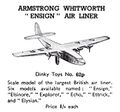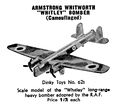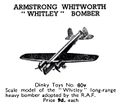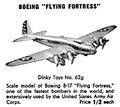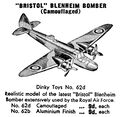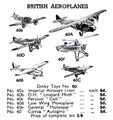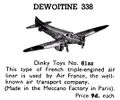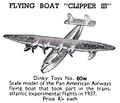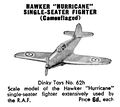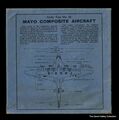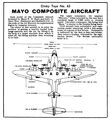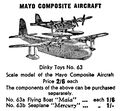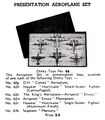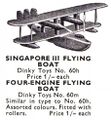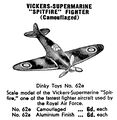Category:Dinky Aircraft (pre-war)
Meccano/Hornby/Dinky :
Modelled Miniatures | Dinky Toys | Supertoys | Dinky Builder | Dublo Dinky |
Army | Boats | Dollhouse | Farm | Planes · 1 · 2 · 3 | Ships |
US FR 1930s | 1940s | 1950s | 1960s | 1970s |
1940: Set No 38: "Set of Camouflaged aircraft" [image info]
Dinky Aircraft range, 1939-40 (page 1 of 3) [image info]
Dinky Aircraft range, 1939-40 (page 2 of 3) [image info]
Dinky Aircraft range, 1939-40 (page 3 of 3) [image info]
1940: Dinky advertising, with further camouflaged versions of models and sets [image info]
Although the Dinky brand is largely associated with toy cars, its pre-war range included quite a substantial range of small-scale contemporary Dinky Toys aircraft, including a number of quirky aircraft like the Mayo composite aircraft, chosen for their distinctiveness and historical importance (for instance, planes that had broken endurance or speed records). With the outbreak of World War Two, some of these become available in a choice of silver paint or camouflage.
Other variations
For some models, Dinky squeezed two model numbers out to the same casting without involving camouflage - a "properly coloured" version with an accurate name for the serious aeroplane enthusiast, and a generic version in a range of assorted (often non-authentic) colours, with a more generic name, for people who just wanted that sort of plane in pretty colours ... for instance, the "Armstrong Whitworth 'Ensign' Air Liner" (62p) was also available in more colours as the more generic "Britsh 40-seater Air Liner" (62x), and the "Junkers Ju 90 Air Liner" (62n) was also available in different colours as the "Giant High-Speed Monoplane" (62y). In the case of the "De Havilland 'Albatross' Mail Liner" (62r), and the "Imperial Airways 'Frobisher' Class Liner" (62w), someone reading the advertising text would not obviously realise that these were essentially the same aircraft: The "Frobisher" was simply the passenger verion of the DH.91 mail aeroplane.
1940 overview article (part.1 of 2)
Aircraft in the Dinky Toys Series
Realistic Scale Models
The keen interest of "M.M." readers in aviation has been further stimulated during the past two or three years by the rapid expansion of the Royal Air Force, and by striking developments in commercial aviation. Descriptions and illustrations of the new types of military and civil aircraft have appeared month by month in the "M,M.' and have aroused undisputed enthusiasm, as is shown by the constant demand for more. The object of this article is to draw attention to the splendid Dinky Toys models of aircraft, which can be handled, examined and compared.
These delightful Dinky Toys models are unique in being designed to scale, with the typical features of each machine reproduced with the greatest possible accuracy. From photographs and dimensioned details. supplied by the builders of the most famous aircraft, the Meccano draughtsmen prepare scale drawings from which skilled toolmakers produce dies of marvellous accuracy. By means of these dies specially designed machines in the great Meccano Factory produce in enormous, numbers the perfect die-cast miniatures that are now being collected so enthusiastically in all parts of the world. There are now nearly 50 different Dinky Toys aircraft, and more are in preparation.
At the present time military aircraft are the most in the news, and among the Royal Air Force machines represented in the Dinky Toys Series are the Hawker "Hurricane," Armstrong Whitworth "Whitley," Fairey "Battle," Gloster "Gladiator," and the Short "Singapore" flying boat.
- The Hawker "Hurricane" (No. 62h) is one of the fastest British fighters, in service to-day. It is a low wing, single-seater monoplane of all-metal construction, and is armed with eight machine guns installed in the wings. It is credited with a top speed of 335 m.p.h. The neat Dinky Toys miniature of this formidable fighter is finished in the brown and green camouflage adopted by the British Air Ministry for Royal Air Force machines. There is also an aluminium finished model (Dinky Toys No. 62s).
- An older type of British single-seater fighter is the Gloster "Gladiator" (No. 60p), which made its first appearance in 1935. It is an equal-span biplane, and in its latest form is armed with six guns. The 830 hp. Bristol Mercury IX engine fitted gives the "Gladiator" a top speed of 250 m.p.h. when flying at a height of 15,500 ft.
- Bombers are a heavier class of military aircraft than fighters, and there are single-engined and twin-engined types in service. One of the best-known of the British twin-engined heavy bombers is the Armstrong Whitworth "Whitley", a middle-wing monoplane of metal, stressed-skin construction. The splendid Dinky Toys model (No. 60v) accurately reproduces the severe design of the prototype, and conveys an impression of the grim purpose for which aircraft of this type are intended. The "Whitley" carries heavy load of bombs, and in defence against pursuing enemy fighters it can reply effectively from three enclosed gun positions, The "Whitleys" of the R.A.F. are camouflaged, and a Dinky Toys miniature finished in the same way (No. 62t) is available.
- An outstanding example of the modern single-engined medium bomber is the Fairey "Battle", one of the first modern monoplane types introduced into the Royal Air Force. The Dinky Toys miniature of this well-known fast bomber (No. 60n) reproduces the slim lines and neat appearance of the actual machine. A camouflaged model (No. 60s) is also available. The "Battle" carries a crew of three and a substantial bomb load, and is equipped with several guns with which to ward off attacks. When fitted with a Rolls-Royce "Merlin" IV engine it has a top speed of 257 m.p.h.
- The Short "Singapore" flying boat (Dinky Toys No, 60h) is a sort of general purpose machine, used for long-distance reconnaissance, coastal patrol, and sometimes bombing operations.
- Giants among bomber aircraft are four-engined machines such as the United States Boeing B-17 "Flying Fortress". This middle wing monoplane is one of the fastest heavy bombers in the world, with a top speed of 250 m.p.h. A magnificent scale model of this fine machine is now included in the Dinky Toys Series under No. 62g. It is beautifully finished, and begs the correct markings of the United States Army Air Corps, by which the actual machines are extensively used. Several fine long-distance flights have been accomplished with these aircraft. In February 1998 six United States Array Air Corps "Flying Fortresses" made a record non-stop mass flight from Miami, Florida, to Buenos Aires, Argentina, covering the distance of 5,260 miles In a total flying time of 27 hrs, 50 min. The single stop en route was at Lima, in Peru. The "Flying Fortress" long-range bomber is an all-metal machine, and normally carries a crew of from five to seven men. There are live guns for defence.
- On the civil aircraft side the Dinky Toys Series includes fine scale miniatures of the Armstrong Whitworth "Ensign" and the "Frobisher" class air liners, two recent types of four-engine transport monoplanes acquired by Imperial Airways, now British Overseas Airways Corporation. The "Ensigns" (No. 62p) have been designed for service on the company's European and Empire air routes. The European type "Ensign" has seating for 40 passengers, and the Empire type for 27 passengers and up to 3¼ tons of freight and mails. The four engines of the "Ensign" are of the 935 h.p. Armstrong Siddeley "Tiger" IXc type, and give it a top speed of 205 m.p.h. and a cruising speed of nearly three miles a minute. Any two of these engines are powerful enough to fly the air liner fully loaded. The navigating equipment includes an "automatic pilot" that maintains a set course without guidance. Six models of these high wing aircraft are available.
- The "Frobisher" class air liners were built by the de Havilland Aircraft Co. Ltd. The fine Dinky Toys miniatures (No. 62w) of this type show that a large air liner can be graceful in appearance. There are three models available. The machine is a long wing streamlined monoplane with a wing span of 105 ft., and retractable undercarriage. It seats 22 passengers, and normally carries a crew of four, consisting of captain, first officer, radio operator and steward. The four engines are of the 525 hp. D.H. "Gypsy Twelves" and give the air liner a maximum level speed of 225 m.p.h. at 8,750 ft.
- The D.H. "Albatross" long-range mail liners produced for the British Air Ministry for experimental long-distance flights are similar to the "Frobisher" in general design, but differ internally. There is a beautiful Dinky Toys model (No. 62r) of one of these streamlined monoplanes. The actual machines are capable of a top speed of 222 m.p.h. at 8,750 ft. With full equipment and crew each liner can transport 1,000 lb. of mail for 2,500 miles non-stop against a continuous 40 m.p.h. headwind, at a cruising speed of 210 m.p.h.
- Among the most popular commercial aircraft represented in the Dinky Series are the Empire Flying Boats (Dinky Toys No. 60R) that have become famous for their fine work in operating Imperial Airways' regular fast air services between this country and Africa, India and Australia. The 12 models of these aircraft available include "Caledonia" and "Cambria" which, before going into service on the normal Empire air routes, achieved fame in the experimental transatlantic flights between Foynes, Eire, and Botwood, Newfoundland, carried out in the summer of 1937 by Imperial Airways and Pan American Airways in preparation for the regular transatlantic air service to Canada and the United States inaugurated last year.
- The Empire flying boats are high wing monoplanes, with hulls 88 ft. 6 in. long, and wings of 114 ft. span. Each boat has accommodation for 24 passengers by day, with sleeping quarters at night for 16, and carries a crew of four. The four 900 hp. "Bristol" Pegasus engines give the flying boat a top speed of nearly 200 m.p.h.
- For Pan American Airways the flying boat "Clipper III" made several experimental crossings of the North Atlantic In 1937, and a most realistic Dinky Toys model (No. 60w) of this huge boat is available. The "Clipper III" is a Sikorsky S-42-B all-metal high wing flying boat fitted with four Pratt and Whitney "Hornet" engines, and has a top speed of 168 m.p.h.
- Sometimes a new type of aeroplane proves so exceptionally efficient that it becomes known and used all over the world. The American Douglas DC-3 is an example of this great popularity, and the excellent Dinky Toys model (No. 60t) of this machine shows a type of which more than 100 are in regular service on American air routes, alone. The Douglas DC-3 is an all-metal twin-engined, low wing monoplane that seats 21 passengers. It has a top speed of 213 m.p.h. Douglas air liners are produced in America by the Douglas Aircraft Co. Inc., and in Europe are made under license by the Fokker Company, of Amsterdam.
- The latest and fastest German air liner is the Junkers Ju 90, and the fine scale model (Dinky Toys No. 62n) gives an accurate impression of the massive proportions of these liners. The Ju 90 is, in fact, designed for heavy load carrying rather than for the attainment of extremely high speeds. It is a four-engined low wing monoplane, and its live passenger cabins seat 40, With Junkers "Jumo" 211 engines it has a top speed of 256 m.p.h.
- No machine in recent years has attracted so much attention as the Mayo Composite Aircraft, and the introduction, of a very line scale miniature of it (Dinky Toys No. 63) has been greatly welcomed. The composite aircraft was invented by Major R. H. Mayo, and built by Short Bros. (Rochester and Bedford) Ltd. to the order of the Air Ministry for experimental long-distance flights. It consists of a four-engined high wing seaplane, "Mercury," mounted upon, and locked to, a four-engined high wing flying boat "Maia." Next month we shall describe this remarkable machine and its Dinky Toys counterpart, and continue our survey of aircraft in the Dinky Toys series.
— , -, , Aircraft in the Dinky Toys Series, , Meccano Magazine, , February 1940
1940 overview article (part.2 of 2)
Aircraft in the Dinky Toys Series
Further Realistic Models
LAST month we concluded our account of some of the splendid scale model aircraft in the Dinky Toys Series with a reference to the famous Mayo Composite Aircraft and the fine miniature of it (Dinky Toys No. 63). For the benefit of new readers we repeat that the composite aircraft was invented by Major R. H. Mayo, and built by Short Bros. (Rochester and Bedford) Ltd. to the order of the Air Ministry, for experimental long-distance flights. It consists of a four-engined high wing seaplane, "Mercury," mounted on and locked to a four-engined high wing flying boat "Maia." The object of this machine is to solve the problem of getting a heavily loaded long-range machine into the air, by lifting it on the back of a larger machine from which it takes off, the lifting machine then returning to its base. Among the fine flights achieved by the upper component, the seaplane "Mercury," after being launched in this way, are the following: July 1938, Foynes, Eire, to Montreal and New York, 3,240 miles; October 1938, Dundee to the Orange River, South Africa, 6,045 miles. "Mercury" has a top speed of 212 m.p.h.
- A British twin-engined commercial monoplane that has proved very successful is the Airspeed "Envoy", designed for passenger or freight carrying. It is a twin-engined low wing machine, and the Dinky Toys miniature (No. 62m) gives an excellent impression of its attractive appearance. The main cabin of the "Envoy" can be equipped to seat up to eight passengers. When fitted with two 310 h.p. Armstrong Siddeley "Cheetah" IX engines, this machine has a top speed of 203 m.p.h.
- An Airspeed "Envoy" was acquired in 1937 by the Air Council for the King's flight, and in the Dinky Toys Series there is a beautiful model of this machine (No. 62k). It is finished in the colours of the actual monoplane, and bears the correct registration letters on the wings. The King's aeroplane differs from the standard "Envoy" only in its luxurious equipment. It has accommodation for four passengers, pilot, radio operator, and steward.
- Another twin-engined low wing monoplane of special interest is the D.H. "Comet", reproduced in Dinky Toys No. 609. It was in a "Comet" that Flying Officer A. E. Clouston and Mr. V. Ricketts made their record flight to New Zealand and back, in 10 days 21 hr. 22 mm. in March 1938. By this tine double flight they completed the first direct round trip by air to New Zealand and back. The "Comet" used by them first became famous in October 1934 when C. W. A. Scott and T. Campbell Black won with it the MacRobertson Air Race by flying from Mildenhall to Melbourne, Australia, in 2 days 23 hrs. 18 sec.
— , -, , Aircraft in the Dinky Toys Series, , Meccano Magazine, , March 1940
The French range
A further expansion of the number of colours and designs was achieved by incorporating further Dinky aircraft from the French offshot company based in Paris. While the British range of Dinky planes was very much Britain-centric, Meccano Paris, selling to the French market, decided that they needed to produce their own range of plane models tailored to the local tastes, France having a proud history of having produced some of the most historically-important aviation pioneers – a French visitor to a local toyshop would probably not be very understanding if the French Dinky range had no French aircraft. Meccano Ltd in Liverpool added some French versions of the sets to their range, by the simple expedient of adding a "z" to the end of the model number or set number to distinguish it from the British version.
In the museum
- The museum is currently planning a quite glorious display of pre-war Dinky aircraft, due to be on display some time in the first half of 2022.
Prewar to ~1940
Transcribed from advertising up until ~1940:
- 60 - Aeroplanes, ×6 (@1936)
- 60a - Imperial Airways Liner
- 60b - D.H. "Leopard Moth"
- 60c - Percival "Gull"
- 60d - Low Wing Monoplane
- 60e - General "Monospar"
- 60f - Cierva "Autogiro"
- 60g - D.H. "Comet" Aeroplane - scale model of the plane used by C.W.A. Scott and the late T.C. Black in their Australian flight.
- 61 - RAF Aeroplanes, ×3 (@1937)
- 60h - "Singapore" Flying Boat
- 60n - Fairey "Battle" Bomber (2)
- 60p - Gloster "Gladiator" Biplane (2)
- 60r - Empire Flying Boats
- Imperial Airways, twelve models:
- - "Caledonia", "Canopus", "Corsair", "Challenger", "Centurion", "Cambria", "Calpurnia", "Ceres", "Clio", "Calypso", "Corinna", "Cheviot"
- 60s - Medium Bomber - similar to 60n, but with Air Ministry Shadow Shading
- 60t - Douglas DC3 Air Liner - in regular service on American and European routes
- 60v - Armstrong Whitworth "Whitley" Bomber
- 60w - Flying Boat "Clipper III" – Pan American Airways flying boat that took part in the transatlantic experimental flights in 1937
- 60x - Atlantic Flying Boat – similar to the 60r Empire Flying Boats (Assorted colours)
- 60y - Refuelling Tender – Thomson Bros Tender used for refuelling aeroplanes at aerodromes
- 60z - Aeroplanes – Six models of famous French aeroplanes, made in Paris
- – "Arc en Ciel" – Potez 58 – Hanriot H180T – Breguet-Corsaire low wing mnoplane – Dewoitine 500 – Cierva Autogyro
- 61z - Aeroplanes – Six models of French aeroplanes, made in Paris
- – Dewoitine 338 – Dewoitine 500d – Potez 58 – Potez 56 – Hanriot H180M – Farman F360
- 62a – Vickers-Supermarine “Spitfire” Fighter (service grey)
- 62b – “Bristol” Blenheim Bomber (Aluminium Finish)
- 62d – “Bristol” Blenheim Bomber (Camouflaged)
- 62e – Vickers-Supermarine “Spitfire” Fighter (Camouflaged)
- 62g – Boeing Flying Fortress Monoplane
- 62h - Hawker "Hurricane" Single-Seater Fighter (Shadow Shaded)
- 62k - The King’s Aeroplane - Airspeed "Envoy" monoplane supplied to the Air Council for the King’s Flight.
- 62m - Airspeed "Envoy" Monoplane – twin-engined commercial monoplane (Assorted colours)
- 62n - Junkers Ju 90 Air Liner – the latest type of German air liner, top speed 246 m.p.h.
- 62p - Armstrong Whitworth "Ensign" Air Liner – the largest British air liner
- – "Ensign" – "Elsinore" – "Explorer" – "Echo" – "Ettrick" – "Elysian"
- 62r - De Havilland "Albatross" Mail Liner
- 62s - Hawker "Hurricane" Single-Seater Fighter (Aluminium Finish) – similar to 62h, but different finish
- 62t - Armstrong Whitworth "Whitley" Bomber – similar to 60v, but with Air Ministry Shadow Shading
- 62w - Imperial Airways "Frobisher" Class Liner
- - "Frobisher" – "Falcon" – "Fortuna"
- 62x - British 40-Seater Air Liner – similar to 62p "Ensign" (Assorted colours)
- 62y - Giant High-Speed Monoplane – similar to 62n, Ju 90 (Assorted colours)
- 60az - Monoplane "Arc-en-Ciel" – the famous French triple-engined monoplane (Paris)
- 63 - Mayo Composite Aircraft
- 63a - Flying Boat "Maia"
- 63b - Seaplane "Mercury"
- 64 – Presentation Aeroplane Set
- 60g – D.H. “Comet” Aeroplane
- 62h – Hawker “Hurricane” Single-Seater Fighter (Shadow Shaded)
- 62s – Hawker “Hurricane” Single-Seater Fighter (Aluminium Finish)
- 62k – The King’s Aeroplane
- 62m – Airspeed “Envoy” Monoplane
- 63b – Seaplane “Mercury”
- 65 – Presentation Aeroplane Set
- 60r – Empire Flying Boat
- 60t – Douglas DC3 Air Liner
- 60v – Armstrong Whitworth “Whitley” Bomber
- 60w – Flying Boat “Clipper III”
- 62n – Junkers Ju 90 Air Liner
- 62p – Armstrong Whitworth “Ensign” Air Liner
- 62r – De Havilland “Albatross” Mail Liner
- 62w – Imperial Airways “Frobisher” Class Liner
See also:
External links
- Powerhouse Museum: Dinky toy 'Low-Wing Monoplane' aircraft (collection.maas.museum)
- Windsor Museum: Dinky Toys Hawker Hurricane (windsormuseum.org.uk)
- Scottish NFA: Dinky aircraft (nationalfundforacquisitions.wordpress.com)
- VandA Museum: 1970s Dinky Toys 729 aircraft (collections.vam.ac.uk)
- Hatfield, Herts, Dinky aircraft (hatfield-herts.co.uk)
meccano magazine articles
Subcategories
This category has the following 5 subcategories, out of 5 total.
B
- British Aeroplanes (Dinky Toys 60) (6 P, 8 F)
C
- Camouflaged Aeroplane Set (Dinky Toys 66) (4 P, 8 F)
F
- French Aeroplanes (Dinky Toys 60z) (1 P, 1 F)
- French Aeroplanes (Dinky Toys 61z) (1 P, 1 F)
Pages in category ‘Dinky Aircraft (pre-war)’
The following 35 pages are in this category, out of 35 total.
A
C
E
F
I
L
P
Media in category ‘Dinky Aircraft (pre-war)’
The following 52 files are in this category, out of 52 total.
- Airspeed Envoy Monoplane, Dinky Toys 62m (MM 1940-07).jpg 2,312 × 1,794; 284 KB
- Airspeed Envoy Monoplane, Dinky Toys 62m 62k (MeccanoCat 1939-40).jpg 1,324 × 1,154; 197 KB
- Amiot 370 monoplane, Dinky Toys 64az (MCat 1939).jpg 1,453 × 1,021; 131 KB
- Armstrong Whitworth Ensign Air Liner, Dinky Toys 62p (MeccanoCat 1939-40).jpg 1,242 × 1,159; 163 KB
- Armstrong Whitworth Whitley Bomber, camouflaged, Dinky Toys 62t (MM 1940-07).jpg 2,421 × 2,130; 394 KB
- Armstrong Whitworth Whitley Bomber, Dinky Toys 60v (MeccanoCat 1939-40).jpg 1,175 × 1,040; 129 KB
- Army Co-operation Autogiro, Dinky Toys 66f (MM 1940-07).jpg 1,436 × 885; 102 KB
- Bloch 220 airliner, Dinky Toys 64bz (MCat 1939).jpg 1,481 × 801; 105 KB
- Boeing Flying Fortress Monoplane, DInky Toys 62g (MeccanoCat 1939-40).jpg 1,278 × 759; 133 KB
- Boeing Flying Fortress, Dinky Toys 62g (MM 1940-07).jpg 2,199 × 1,963; 349 KB
- Bristol Blenheim Bomber, camouflaged, Dinky Toys 62d (MM 1940-07).jpg 2,145 × 2,100; 408 KB
- British Aeroplanes, Dinky Toys 60 (MeccanoCat 1939-40).jpg 1,342 × 1,423; 238 KB
- Camouflaged Aeroplane Set, Dinky Toys 66 (MM 1940-07).jpg 1,600 × 1,197; 213 KB
- Camouflaged Aircraft Set, label artwork (Dinky Toys Set No 68).jpg 3,000 × 1,843; 1.73 MB
- Dewoitine 338, Dinky Toys 61az (MeccanoCat 1939-40).jpg 1,069 × 887; 120 KB
- DH 'Comet' Aeroplane, Dinky Toys 60g (1935 BoHTMP).jpg 583 × 313; 50 KB
- DH Comet Aeroplane, Dinky Toys 60g (MeccanoCat 1939-40).jpg 1,081 × 536; 68 KB
- DH Flamingo Liner, Dinky Toys 62f (MeccanoCat 1939-40).jpg 1,051 × 866; 132 KB
- DH Leopard Moth aeroplane, Dinky Toys 60b (1935 BoHTMP).jpg 397 × 237; 15 KB
- Dinky Aircraft, p62 (MeccanoCat 1939-40).jpg 1,200 × 806; 201 KB
- Dinky Aircraft, p63 (MeccanoCat 1939-40).jpg 1,200 × 807; 195 KB
- Dinky Aircraft, p64 (MeccanoCat 1939-40).jpg 1,200 × 808; 227 KB
- Dive-Bomber Fighter, camouflaged, Dinky Toys 66b (MM 1940-07).jpg 1,328 × 820; 87 KB
- Douglas DC-3 Air Liner, Dinky Toys 60t (MeccanoCat 1939-40).jpg 1,178 × 798; 107 KB
- Empire Flying Boat, Dinky Toys 60r (MeccanoCat 1939-40).jpg 1,181 × 882; 141 KB
- Fairey Battle Bomber, camouflaged, Dinky Toys 60s (MM 1940-07).jpg 2,186 × 1,660; 250 KB
- Flying Boat, Clipper III, Dinky Toys 60w (MeccanoCat 1939-40).jpg 1,158 × 997; 155 KB
- French Aeroplanes, Dinky Toys 60z (MeccanoCat 1939-40).jpg 2,161 × 1,119; 241 KB
- French Aeroplanes, Dinky Toys 61z (MeccanoCat 1939-40).jpg 2,151 × 1,124; 245 KB
- General 'Monospar' aeroplane, Dinky Toys 60e (1935 BoHTMP).jpg 385 × 211; 14 KB
- Hawker Hurricane Single-Seater Fighter, camouflaged, Dinky Toys 62h (MM 1940-07).jpg 2,127 × 1,899; 303 KB
- Heavy Bomber, camouflaged, Dinky Toys 66a (MM 1940-07).jpg 1,535 × 847; 114 KB
- Imperial Airways Frobisher Class Liner, Dinky Toys 62w (MM 1940-07).jpg 2,310 × 1,812; 316 KB
- Imperial Airways Liner, Dinky Toys 60a (1935 BoHTMP).jpg 420 × 259; 21 KB
- Junkers JU 89 Heavy Bomber, Dinky Toys 67a (MM 1940-07).jpg 2,789 × 2,130; 448 KB
- Junkers Ju 90 Air Liner, Dinky Toys 62n (MeccanoCat 1939-40).jpg 1,242 × 901; 131 KB
- Mayo Composite Aircraft, box lid (Dinky Toys 63).jpg 2,969 × 3,000; 1.69 MB
- Mayo Composite Aircraft, box lid artwork (Dinky Toys No63).jpg 2,770 × 3,000; 762 KB
- Mayo Composite Aircraft, Dinky Toys 63 (MCat 1939).jpg 1,444 × 878; 122 KB
- Mayo Composite Aircraft, Dinky Toys 63 (MM 1940-07).jpg 2,168 × 2,008; 423 KB
- Medium Bomber, camouflaged, Dinky Toys 66e (MM 1940-07).jpg 1,173 × 711; 74 KB
- Monoplane Arc-En-Ciel, Dinky Toys 60az (MeccanoCat 1939-40).jpg 1,083 × 883; 124 KB
- Percival Gull aeroplane, Dinky Toys 60c (1935 BoHTMP).jpg 319 × 193; 12 KB
- Presentation Aeroplane Set, Dinky Toys 65 (MCat 1939).jpg 1,508 × 2,054; 376 KB
- Presentation Aircraft Set, Dinky Toys 64 (MeccanoCat 1939-40).jpg 1,527 × 1,748; 369 KB
- Presentation Aircraft Set, Dinky Toys 65 (MeccanoCat 1939-40).jpg 1,535 × 2,025; 543 KB
- RAF Aeroplanes Set, Dinky Toys 61 (MeccanoCat 1939-40).jpg 2,283 × 901; 222 KB
- Singapore III Flying Boat, Dinky Toys 60h (MM 1936-06).jpg 907 × 979; 127 KB
- Torpedo Dive Bomber, camouflaged, Dinky Toys 66d (MM 1940-07).jpg 1,316 × 801; 92 KB
- Two-Seater Fighter, Dinky Toys 66c (MM 1940-07).jpg 1,171 × 721; 71 KB
- Vickers-Supermarine Spitfire, camouflaged, Dinky Toys 62e (MM 1940-07).jpg 2,148 × 2,206; 388 KB
